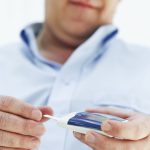For people living with Diabetes (either Type 1 Diabetes or Type 2 Diabetes on insulin therapy), insulin is the key to survive. This means taking insulin injection every single time you eat which could vary from 4-5 times a day.
There are different areas of the body wherein insulin could be injected, we refer to them as insulin injection sites. These are areas with fatty tissue such as:
-
belly (at least 2 fingers space from the belly button)
-
sides and back of upper arms
-
front and sides of thighs
-
upper buttocks
Avoiding lipo
A very important and often forgotten aspect, when you are on insulin, is site rotation. It is vital that you choose a different site each time and maintain a distance of at least 2 fingers from where you last injected. If you keep on injecting at the same site, the tissues under that area start to harden and you may notice hard lumps beneath your skin. This condition is called Lipohypertrophy, also known as lipo. The area may feel hard, thick, swollen and even numb.
Other than looking unappealing cosmetically, it can hamper the absorption of insulin by the body. The insulin might be absorbed more slowly or quickly than expected. This can cause instances of high blood sugars (hyperglycemia), low blood sugars (hypoglycemia), Diabetes ketoacidosis (DKA), requirement for higher insulin doses and poor HbA1c control.
These lumps usually have less sensation or feel numb, hence people, especially kids prefer to use these sites to reduce pain from injections. This will not only worsen the lumps but also affect your blood glucose.
Lipohypertrophy does not spread but the lumps will get bigger over time. The condition can come back if you don’t rotate injection sites and repeat injecting at the same site or another site. Please note that areas affected by lipohypertrophy would never be bruised, painful or have any discoloration of the skin. If you see any such symptoms, seek immediate medical attention. It could be a sign of infection or another problem.
Self-check
It is recommended to self-check for lipohypertrophy monthly by firmly stroking the insulin injection sites with 3 fingers. In case you notice skin hardening or lumps, it is better to skip the site for injection for some time till the area feels normal again. This duration can vary from few weeks to few months to years, depending on the severity of lipohypertrophy. The best treatment for lipohypertrophy is not to inject on that area till it heals. Medical procedures like liposuction or surgical removal could also be considered if the above method does not work. Self-check the affected site regularly and get in touch with your doctor or healthcare provider to check on the healing process.
I can tell by my personal example. I have been living with Type 1 Diabetes for the past 21 years now. I was diagnosed when I was 11 years old and as a kid, I did not like the pain of injections. I did notice formation of lumps under my skin on the thighs but since I did not feel much pain in this area, I happily continued to take injections on the same site. I continued with this for a good whole year until my HbA1c shot up and on inspection, the doctor noticed severe lipohypertrophy on my thighs. I had to skip the site for almost 2 years for it to look and feel normal and heal completely. If you are taking all necessary steps for managing Diabetes and still have poor control on your blood glucose, it is time to check for lipohypertrophy.
To avoid lipohypertrophy, it is important that you continuously rotate the site of insulin injections. For example, I take my bolus shots on my tummy (interchanging the sides each time) and basal shots on my thigh. You can keep track of injection sites by using a chart, an app or simply noting it in a notebook. Same is applicable for finger pricking to test blood sugars. It is important that you make it a conscious habit to be aware of the sites you are injecting at
Snehal Nandagawli has been living with type one Diabetes since 21 years. Professionally she works as an IT engineer with PwC India. She’s a passionate diabetes advocate and volunteers at the Blue Circle Diabetes Foundation.
 n
n














